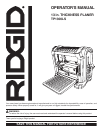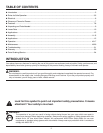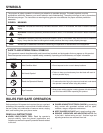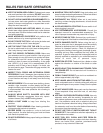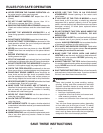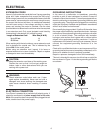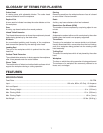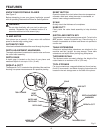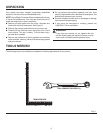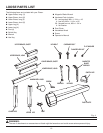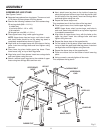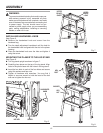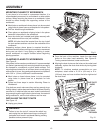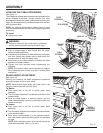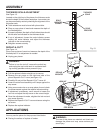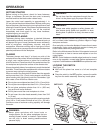
5
RULES FOR SAFE OPERATION
NEVER PERFORM THE PLANING OPERATION with
the cutter head or cutter guard removed.
NEVER MAKE A PLANING CUT deeper than 1/8 in.
(3 mm).
DO NOT PLANE MATERIAL shorter than 14 in.
(356 mm) or narrower than 3/4 in. (19 mm).
MAINTAIN THE PROPER RELATIONSHIP between the
infeed and outfeed surfaces and the cutter head blade
path.
SUPPORT THE WORKPIECE ADEQUATELY at all
times during operation; maintain control of the work at all
times.
DO NOT BACK THE WORK toward the infeed table.
DO NOT ATTEMPT TO PERFORM an abnormal or little
used operation without the use of sturdy and adequate
jigs, fixtures, stops, and the like.
NEVER plane more than one piece at a time. DO NOT
PLANE more than one workpiece on the planer table at
a time.
BEFORE STARTING UP, recheck to make certain all
holding screws are tight.
STOP THE MACHINE and recheck the hex head bolts
and blades for tightness after about 50 hours of operation.
DO NOT FORCE FEED THE WORKPIECE through the
machine. Let the planer apply the proper feed rate.
CHECK THE FEED ROLLERS occasionally to be sure
there are no chips or sawdust between any components.
PLANE ONLY SOUND LUMBER; there should be no
loose knots and as few tight knots as possible. Make
sure the workpiece is free from nails, screws, stones, or
other foreign objects that could break or chip the blades.
NEVER STAND DIRECTLY IN LINE with either the infeed
or outfeed sides. Stand off to one side.
MAKE SURE THE BLADES ARE ATTACHED as
described in the operation section. The blades are sharp
and can easily cut your hand. Use caution in handling
the blades and cutter head guard.
NEVER PUT YOUR FINGERS into the dust chute or
under the cutter guard.
ALLOW THE CUTTER HEAD to reach full speed before
using the planer.
REPLACEMENT PARTS. All repairs, whether electrical
or mechanical, should be made at your nearest authorized
service center.
DO NOT attempt to turn cutter head with hands.
WHEN SERVICING, use only identical replacement parts.
Use of any other parts may create a hazard or cause
product damage.
NEVER USE THIS TOOL IN AN EXPLOSIVE
ATMOSPHERE. Normal sparking of the motor could
ignite fumes.
IF ANY PART OF THIS TOOL IS MISSING or should
break, bend, or fail in any way, or should any electrical
component fail to perform properly, shut off the power
switch, remove the plug from the power source and have
damaged, missing, or failed parts replaced before
resuming operation.
DO NOT OPERATE THIS TOOL WHILE UNDER THE
INFLUENCE OF DRUGS, ALCOHOL, OR ANY
MEDICATION.
ALWAYS STAY ALERT! Do not allow familiarity (gained
from frequent use of your planer) to cause a careless
mistake. ALWAYS REMEMBER that a careless fraction
of a second is sufficient to inflict serious injury.
STAY ALERT AND EXERCISE CONTROL. Watch what
you are doing and use common sense. Do not operate
tool when you are tired. Do not rush.
MAKE SURE THE WORK AREA HAS AMPLE
LIGHTING to see the work and that no obstructions will
interfere with safe operation BEFORE performing any
work using your planer.
ALWAYS TURN OFF THE TOOL before disconnecting
it to avoid accidental starting when reconnecting to power
supply. NEVER leave the tool unattended while connected
to a power source.
SAVE THESE INSTRUCTIONS. Refer to them frequently
and use them to instruct other users. If you loan someone
this tool, loan them these instructions also.
WARNING:
Some dust created by power sanding, sawing,
grinding, drilling, and other construction activities
contains chemicals known to cause cancer, birth
defects or other reproductive harm. Some examples
of these chemicals are:
• lead from lead-based paints,
• crystalline silica from bricks and cement and
other masonry products, and
• arsenic and chromium from chemically-treated
lumber.
Your risk from these exposures varies, depending
on how often you do this type of work. To reduce
your exposure to these chemicals, work in a well
ventilated area and work with approved safety equip-
ment, such as those dust masks that are specially
designed to filter out microscopic particles.
SAVE THESE INSTRUCTIONS



